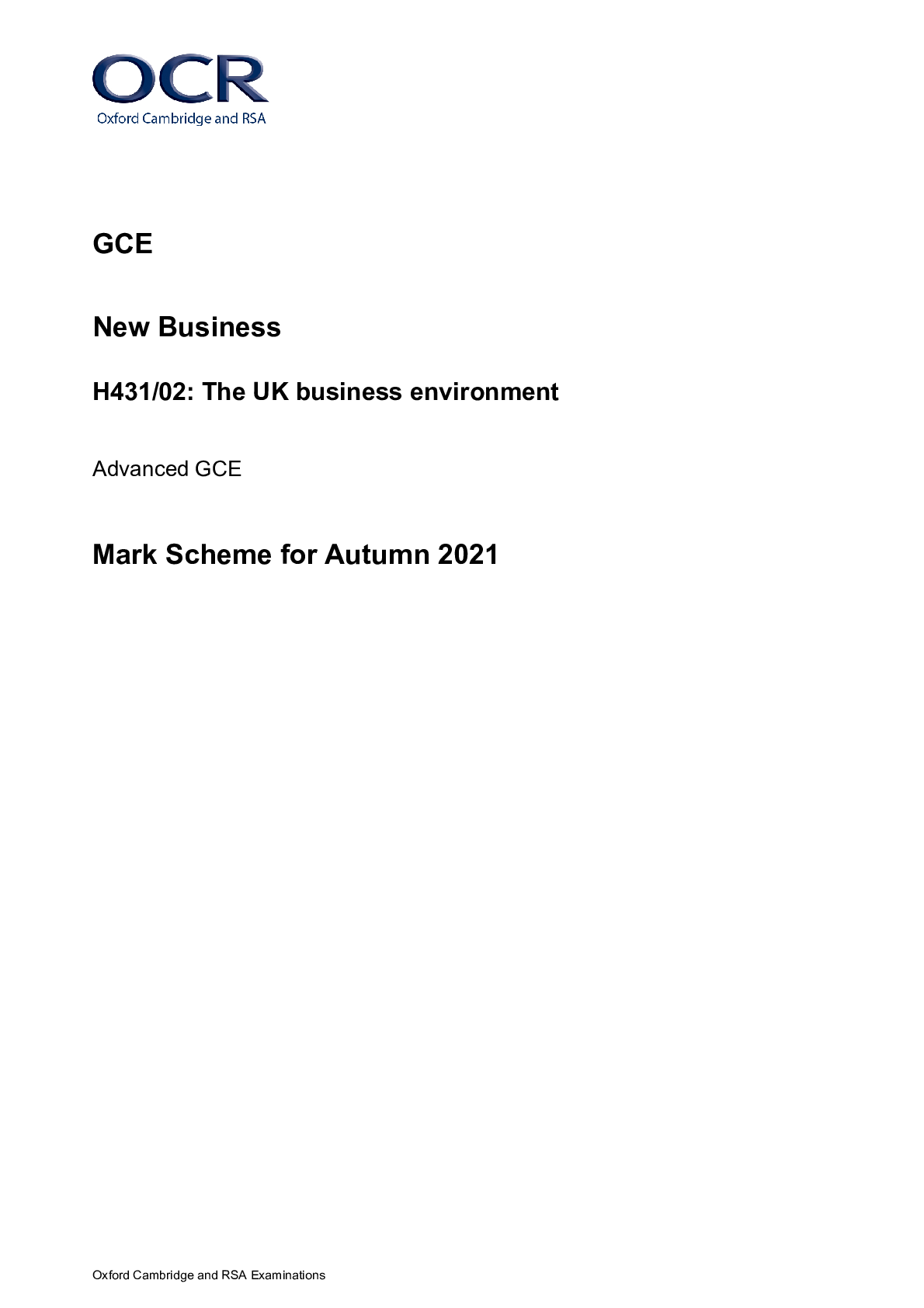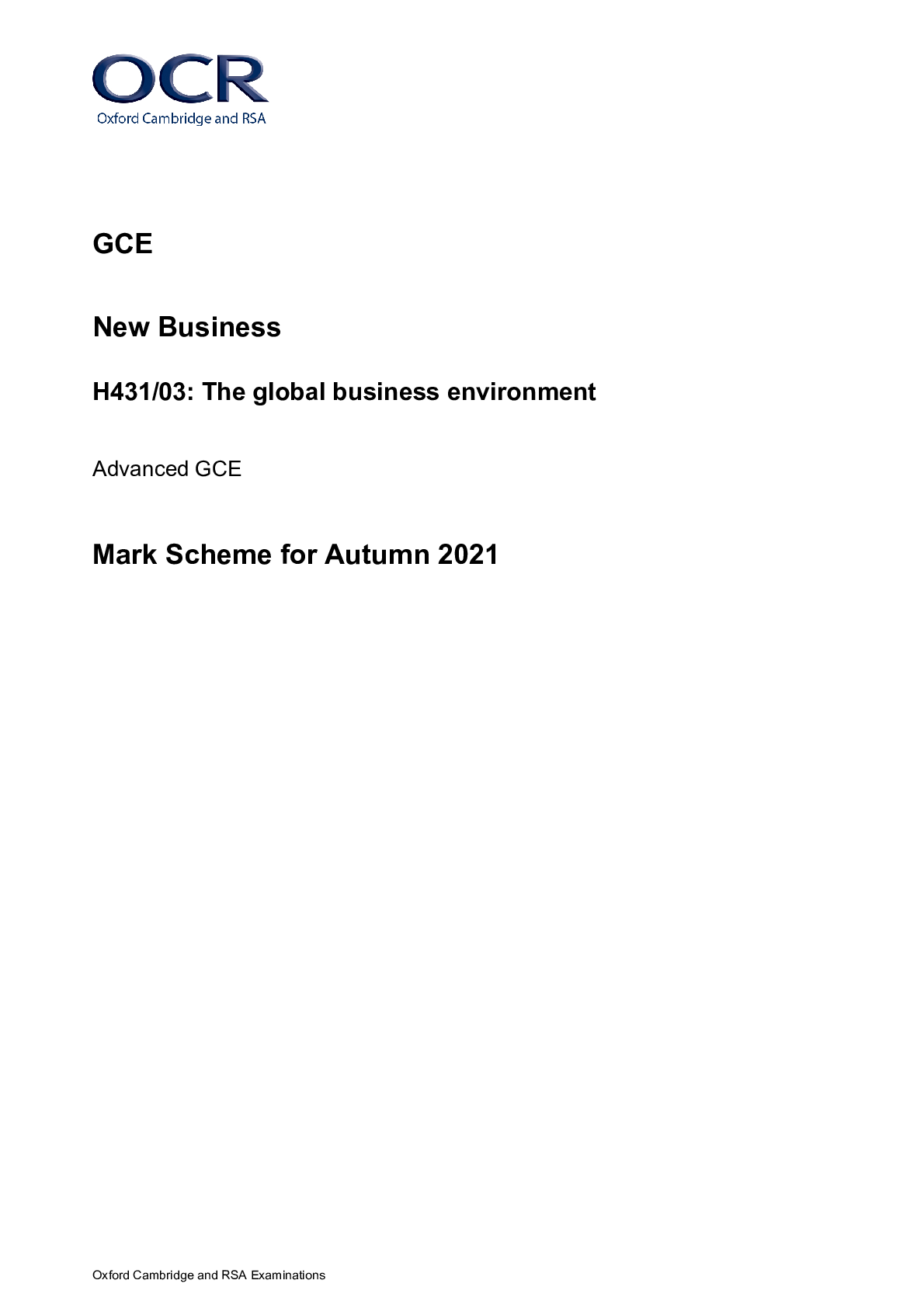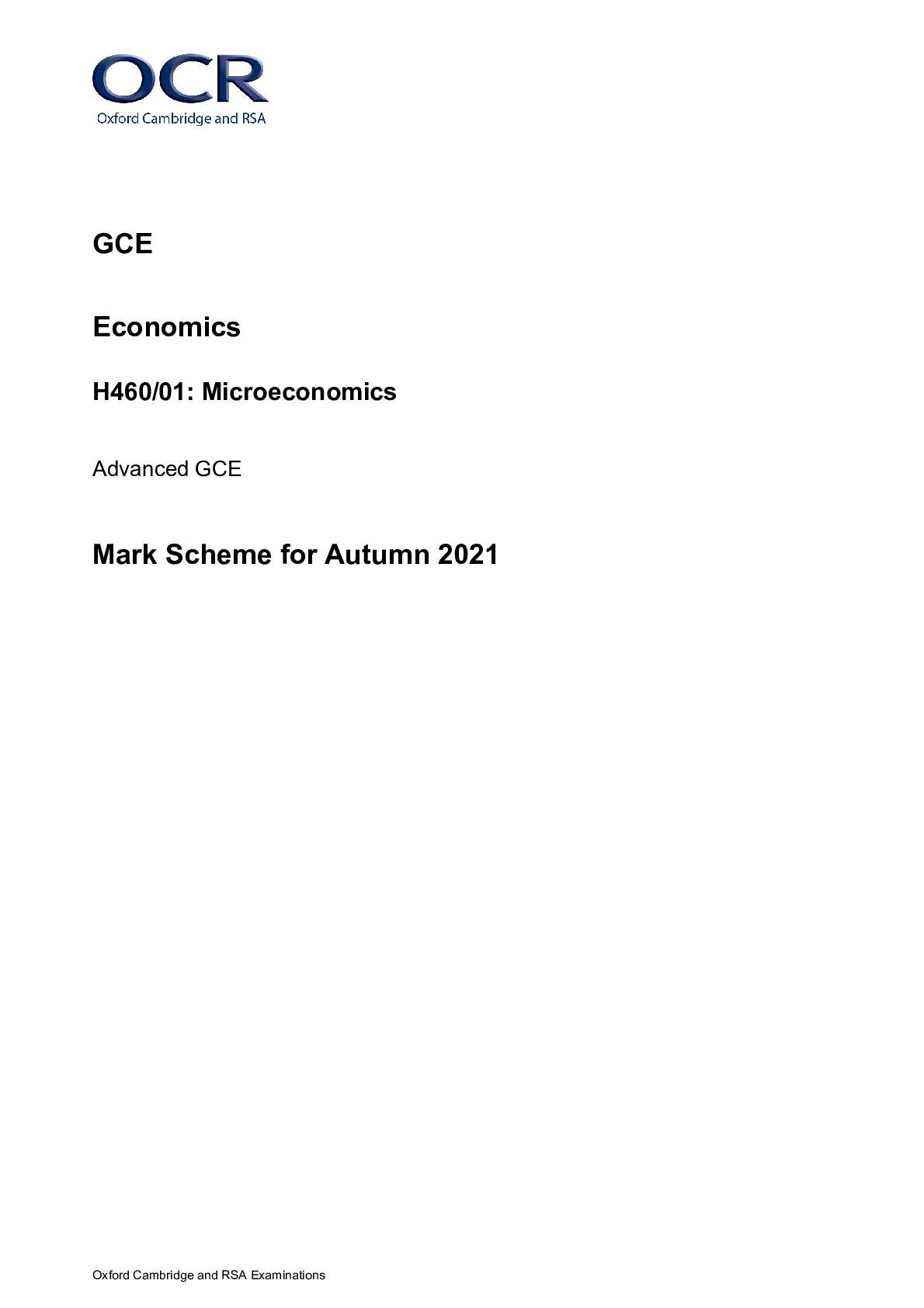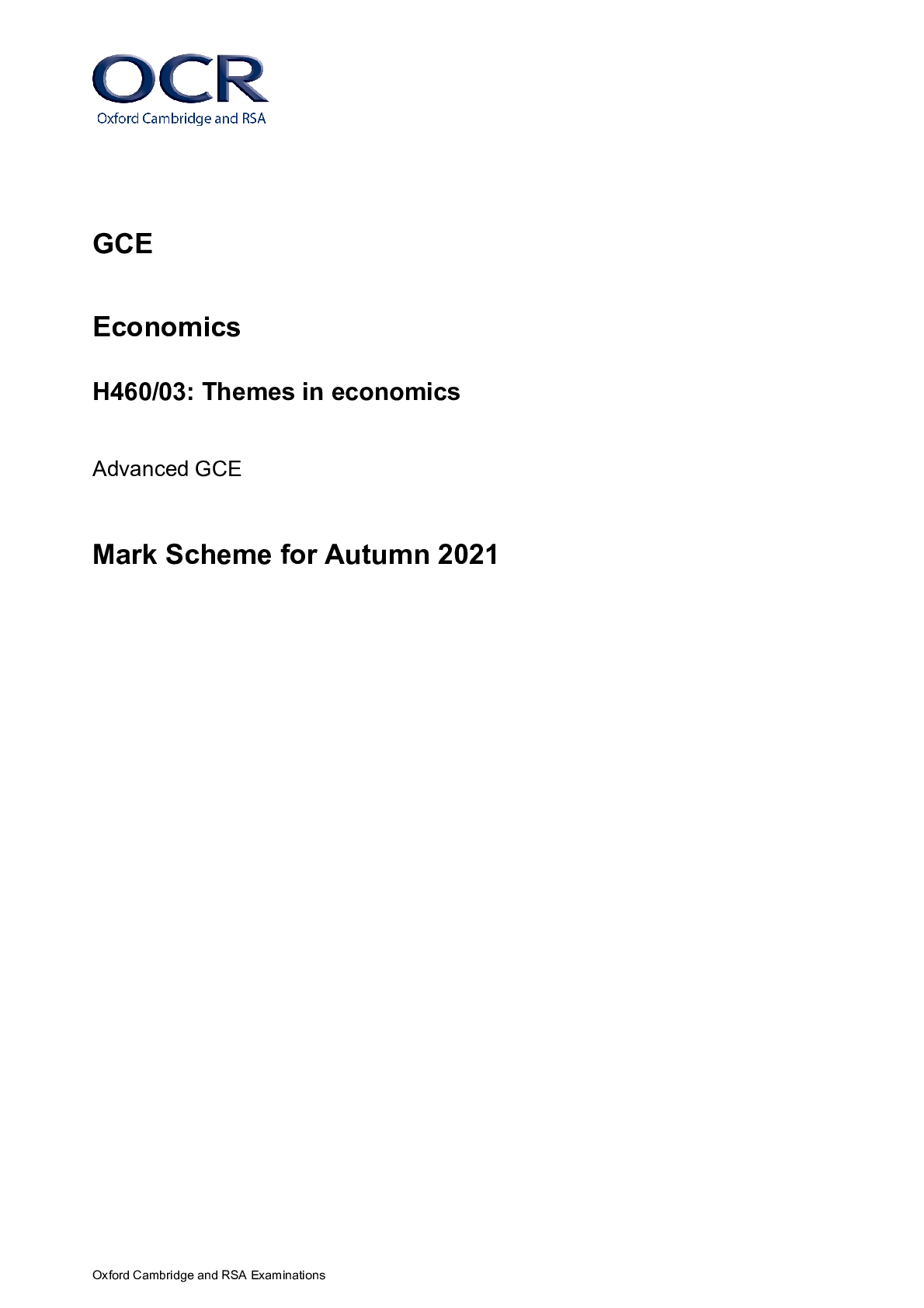Media Studies > MARK SCHEME > GCE Media Studies H409/02: Evolving media Advanced GCE Mark Scheme for November 2020 (All)
GCE Media Studies H409/02: Evolving media Advanced GCE Mark Scheme for November 2020
Document Content and Description Below
GCE Media Studies H409/02: Evolving media Advanced GCE Mark Scheme for November 2020 Oxford Cambridge and RSA Examinations GCE Media Studies H409/02: Evolving media Advanced GCE Mark Schem... e for November 2020Oxford Cambridge and RSA Examinations OCR (Oxford Cambridge and RSA) is a leading UK awarding body, providing a wide range of qualifications to meet the needs of candidates of all ages and abilities. OCR qualifications include AS/A Levels, Diplomas, GCSEs, Cambridge Nationals, Cambridge Technicals, Functional Skills, Key Skills, Entry Level qualifications, NVQs and vocational qualifications in areas such as IT, business, languages, teaching/training, administration and secretarial skills. It is also responsible for developing new specifications to meet national requirements and the needs of students and teachers. OCR is a not-for-profit organisation; any surplus made is invested back into the establishment to help towards the development of qualifications and support, which keep pace with the changing needs of today’s society. This mark scheme is published as an aid to teachers and students, to indicate the requirements of the examination. It shows the basis on which marks were awarded by examiners. It does not indicate the details of the discussions which took place at an examiners’ meeting before marking commenced. All examiners are instructed that alternative correct answers and unexpected approaches in candidates’ scripts must be given marks that fairly reflect the relevant knowledge and skills demonstrated. Mark schemes should be read in conjunction with the published question papers and the report on the examination. © OCR 2020H409/02 Mark Scheme November 2020 2 Annotations Stamp Description Blank page N/A Highlight Off page comment Tick Cross Unclear Omission mark Terminology Example/Reference Accurate Lengthy narrative Expandable vertical wavy line Vague Knowledge and understanding Not answered question No example OpinionH409/02 Mark Scheme November 2020 3 SUBJECT–SPECIFIC MARKING INSTRUCTIONS Introduction Your first task as an Examiner is to become thoroughly familiar with the material on which the examination depends. You should ensure that you have copies of these materials: • the specification, especially the assessment objectives • the question paper and its rubrics • the mark scheme. You should ensure also that you are familiar with the administrative procedures related to the marking process. These are set out in the OCR booklet Instructions for Examiners. If you are examining for the first time, please read carefully Appendix 5 Introduction to Script Marking: Notes for New Examiners. Please ask for help or guidance whenever you need it. Your first point of contact is your Team Leader. Information and instructions for examiners The co-ordination scripts provide you with examples of the standard of each band. The marks awarded for these scripts will have been agreed by the Team Leaders and will be discussed fully at the Examiners’ Co-ordination Meeting. The specific task-related indicative content for each question will help you to understand how the band descriptors may be applied. However, this indicative content does not constitute the mark scheme: it is material that candidates might use, grouped according to each assessment objective tested by the question. It is hoped that candidates will respond to questions in a variety of ways. Rigid demands for ‘what must be a good answer’ would lead to a distorted assessment. Candidates’ answers must be relevant to the question. Beware of prepared answers that do not show the candidate’s thought and which have not been adapted to the thrust of the question. Beware also of answers where candidates attempt to reproduce interpretations and concepts that they have been taught but have only partially understood. Using the Mark Scheme Please study this Mark Scheme carefully. The Mark Scheme is an integral part of the process that begins with the setting of the question paper and ends with the awarding of grades. Question papers and Mark Schemes are developed in association with each other so that issues of differentiation and positive achievement can be addressed from the very start. This Mark Scheme is a working document; it is not exhaustive; it does not provide ‘correct’ answers. The Mark Scheme can only provide ‘best guesses’ about how the question will work out, and it is subject to revision after we have looked at a wide range of scripts. The Examiners’ Standardisation Meeting will ensure that the Mark Scheme covers the range of candidates’ responses to the questions, and that all Examiners understand and apply the Mark Scheme in the same way. The Mark Scheme will be discussed and amended at the meeting, and administrative procedures will be confirmed. Co-ordination scripts will be issued at the meeting to exemplify aspects of candidates’ responses and achievements; the co-ordination scripts then become part of this Mark Scheme. Before the Standardisation Meeting, you should read and mark in pencil a number of scripts, in order to gain an impression of the range of responses and achievement that may be expected.H409/02 Mark Scheme November 2020 4 Please read carefully all the scripts in your allocation and make every effort to look positively for achievement throughout the ability range. Always be prepared to use the full range of marks. For answers marked by levels of response: a. To determine the level – start at the highest level and work down until you reach the level that matches the answer b. To determine the mark within the level, consider the following: Descriptor Award mark On the borderline of this level and the one below At bottom of level Just enough achievement on balance for this level Above bottom and either below middle or at middle of level (depending on number of marks available) Meets the criteria but with some slight inconsistency Above middle and either below top of level or at middle of level (depending on number of marks available) Consistently meets the criteria for this level At top of level Subject–specific marking Instructions Levels of Response targeting AO1 and AO2 Where a mark scheme targets marks at AO1 and AO2, there is no requirement for a response to be awarded in the same level for AO1 as for AO2, so for example a response could be awarded Level 3 for AO1 and Level 2 for AO2.H409/02 Mark Scheme November 2020 5 1 Explain how public service broadcast radio shows can use audience data to influence their content. Refer to The BBC Radio One Breakfast Show to support your answer. In your answer you must consider how economic, political and cultural contexts influence the content of radio shows Assessment Objectives AO1: 1a 1b – Demonstrate knowledge and understanding of the theoretical framework of media. AO1: 2a 2b – Demonstrate knowledge and understanding of contexts of media and their influence on media products and processes. AO1 Total: 15 marks. Question Indicative Content 1 The content below is not prescriptive and all valid points should be credited. It is not expected that responses will include all of the points listed. AO1:1 Responses might refer to: • Processes of radio production that have been influenced by audience data. • The role of regulatory frameworks and political factors (such as the PSB remit, Ofcom and the Royal Charter) in influencing radio content. • An awareness of budget(s) for broadcast radio shows and allocation to attract, reach or maintain specific audiences. • How technology is used by radio producers to gather, process and measure audience data. • A commentary on the usefulness of radio audience measuring tools, such as RAJAR, and participatory media (social media channels) in considering the impact on audiences. • The fragmentation of audiences between traditional radio consumption versus online/digital platforms and applications. Responses should demonstrate knowledge and understanding of audiences, such as: • How media industries (radio) categorise, target and define different audiences. • How audiences are grouped/ categorised by media industries, including by demographics such as age, gender and social class (data), as well as psychographics such as lifestyle/ taste. • How content is produced to be appealing to the ‘types’ of audience that is defined by data, possibly linked to ideas related to Uses and Gratifications theory.H409/02 Mark Scheme November 2020 6 Responses might explain how radio programmes such as The BBC Radio One Breakfast Show (R1BS) use data to influence content, such as: • Appealing to a wide range of audiences to inform, educate and entertain in line with their remit through diverse content. • Responding to data, including RAJAR figures (up to September 2018) highlighting the need to produce content to attract and maintain audiences who now use phones more than listening to radio (15% fewer than the generation before them). • How radio stations consult with audiences to manage their content, including music, news and celebrity content. • Significance of online media and social sites (Facebook pages, podcasts, YouTube channels etc.) requiring engaging new content to meet the online audiences. • Creating opportunities for synergy between shows (e.g. using the BBC Sounds app, simulcasts of 1xtra highlights and use of podcasts). • Significance of licence fee funding and the need to ensure content can justify budgets (there may be counter-arguments as to why the BBC doesn’t always meet the PSB remit) • To create opportunities for interaction, traditional phone-ins, use of Twitter, competitions to attend ‘unique’ Radio 1 shows and festivals as part of the station’s remit etc and generate long-tail style content across online platforms. • An indication that specific focus on the distinctive 15–29-year-old audience has affected programme’s content and their attempt to reverse audiences decline (Grimshaw being replaced by James to overturn steady decline). • Use of playlists decided by committee to attract audiences, shared on website, highlighting how content must reflect the diversity of category a, b and c artists. • R1BS‘s focus on diversity of young people in the UK today which can affect the content. AO1: 2 Responses might refer to: • How economic, political and cultural contexts influence the content of radio shows. • How the political context of PSB and Reithian values influence the R1BS content. • The political and cultural contexts of news and current affairs that need to be included on the Newsbeat section to remain relevant and appropriate for content of show/ target audience. • The cultural contexts of celebrities and artists who may influence the show’s content dependent on whether they are categorised as A, B or C artists. • Economic and political contexts linked to the licence fee, the BBC’s charter and competition from commercial broadcasters. • Political contexts that may influence the viewpoint and angle taken by radio industries in how they shape their content to remain politically unbiased (neutral). • Cultural contexts that may influence the need to include all material relevant to all sections of society and not exclude certain members, including LGBTQ+, BAME etc. • Cultural contexts that may influence the show and the BBC’s need to reflect Britain to the world.H409/02 Mark Scheme November 2020 7 Question Level Mark Scheme Mark 1 3 A comprehensive response to the set question. A comprehensive demonstration of knowledge and understanding of how audience data can influence the content of PSB radio: • Comprehensive, detailed and accurate knowledge and understanding of the radio industry. • Clear and precise explanation of how audience data influences radio show content. • Answer is supported by detailed and accurate reference to The BBC Radio One Breakfast Show. Comprehensive, detailed and accurate knowledge and understanding of a range of contexts and their influence on the radio industry. 11-15 2 An adequate response to the set question. An adequate demonstration of knowledge and understanding of how audience data can influence the content of PSB radio: • Adequate and generally accurate knowledge and understanding of the radio industry. • Generally accurate explanation of how audience data influences radio show content. • Answer is supported by generally accurate reference to The BBC Radio One Breakfast Show. Adequate and generally accurate knowledge and understanding of one or more contexts and their influence on the radio industry. 6-10 1 A minimal response to the set question. A minimal demonstration of knowledge and understanding of how audience data can influence the content of PSB radio: • Knowledge of radio industry is minimal, demonstrating little understanding • Explanation of how audience data influences radio show content is minimal and may not always be accurate or is largely descriptive. • Reference to examples from The BBC Radio One Breakfast Show to support the answer is minimal and may be inaccurate or dwell on only one point. Knowledge of media contexts and their influence on the radio industry is minimal and/or descriptive, demonstrating little understanding. 1–5 0 No response or no response worthy of credit. 0H409/02 Mark Scheme November 2020 8 2 Explain how the arrival of digitally convergent media platforms has impacted on film producers. Refer to Disney and its 1967 and 2016 versions of The Jungle Book to support your answer. Assessment Objectives AO1: 1a 1b – Demonstrate knowledge and understanding of the theoretical framework of media. AO1 Total: 15 marks. Question Indicative Content 2 Content below is not prescriptive and all valid points should be credited. It is not expected that responses will include all the points listed. AO1:1 Responses will demonstrate knowledge and understanding of film producers (exemplified by Disney) and how the arrival of digitally convergent media platforms affected the way they made and distributed films (exemplified by relevant differences between the making of the 1967 and 2016 versions of The Jungle Book). Answers should be focused specifically on the effect on the producers (rather than the wider film industry) and how changes in technology were reflected by changes in approach. Answers might include consideration of: • Differences in how film producers use available hardware and the opportunities this has provided. In relation to Disney, animation technology: the 1967 version was made using traditional cel animation, which had become the industry standard whilst the 2016 version was created using a range of convergent technologies not available in the 1960s, including CGI. This has led to Disney changing its overall approach to film-making; it has not made a “traditional” cel animation film for decades. • Differences in marketing which have changed how film producers approach the distribution of their work. In relation to The Jungle Book, the 1967 version followed a very traditional approach (cinema release followed by home media, several re-releases and “vaulting” to drive demand) whilst the 2016 version was able to make use of a far broader range of convergent platforms for its promotion – Disney’s conglomerate status allows for marketing across a range of platforms (TV, websites, podcasts) as well as social media - JB16 Facebook, Twitter and Instagram accounts which released teasers and “making of” photos/ videos (including behind the scenes) in the months before the theatrical release, not to mention an interactive movie poster on Snapchat. • Differences in ownership and control in media industries – the media landscape of 1967 was significantly more diverse than it is today, partly due to the fragmented nature of the media itself, leading to a far less integrated approach to film production. With relation to Disney, in 1967, it was not the conglomerate that it is today. Although the company had a lot of control over distribution, this was still very much focused within its traditional film production arm (and the influence of Walt Disney himself). Disney in 2016 was a far broader entity, and the process of vertical and horizontal integration (particular involving the application of digital platforms) affected the way in which the trailers and other marketing materials were produced, distributed and circulated across multi-media platforms, many controlled by Disney itself; comparison might thus be made between the analogue “traditional” film industry in 1960s (which was less integrated and had fewer means of distributing such materials) and that of the 2010s (which allowed for a far broader marketing process due to changes in technology and society).H409/02 Mark Scheme November 2020 9 • Differences in expectation of audiences – in the 1960s, an audience was likely to expect that a film was an entity in itself; a modern audience is now conditioned to see a film as a convergent product from which other products across a range of platforms will develop. Regarding the 1967 version of TJB, although there was a belated sequel in 2003, the film was produced purely for cinematic release as part of Disney’s yearly schedule. Disney’s awareness now is that it is producing product which will be distributed digitally on a range of platforms (for example, Blu Ray and Disney+) which was not a concern in the 1960s when such technologies did not exist. Disney therefore needs to consider not only the film itself but also elements such as “DVD extras” which will also be created at the same time as the main film as well as formats (JB 2016 was released in ‘Disney Digital 3-D’, RealD 3D, IMAX 3D, D-Box, and other premium large formats as well as 2D). • Differences in the use of synergy to market products – there were far fewer opportunities for producers to broaden the profile of their films in the 1960s. Considering Disney, the 1967 version of TJB had a simpler approach such as the use of a theme park ride. The 2016 version was promoted at theme parks and other convergent business enterprises, including online streaming platforms (Disney + Nov 2019), social media, TV channels (ESPN and Superbowl); sequels are also in the offing. • Differences in brand identity and culture – many studios from the “classic” era of cinema have vanished; those that remain have begun revisiting (and trading on) their past successes using a more integrated approach made possible by convergent platforms. Disney’s approach to production is endemic of this. In 1967, TJB was produced partly as a response to the perceived failure of The Sword in the Stone and had little heritage (beyond the title). The 2016 version trades very much on the success not only of the 1967 version but also on Disney’s status as a long-established brand; more significantly, it represents Disney’s new approach of taking existing properties and remaking them using convergent technologies (in this case combining live action with CGI in a way which was not possible before), expressing Disney’s adoption of contemporary film-making techniques (in the same way that Disney in 1967 was at the cutting edge of traditional animation). • Any other relevant response discussing the impact of convergent technologies on the approaches taken by media producers. Responses should refer to Disney and to both versions of The Jungle Book from 1967 and 2016 and might consider the following: • How the 2016 film was heavily influenced by intertextual references to the original 1967 film, with CGI and live action converging in order to “reboot” key moments. • Both films being labelled with the Disney brand, one of the ‘Big Six’ film studios for which vertical integration (linked to convergent technologies) is key to the monetary success of each film. • Marketing materials were distributed across a range of platforms for both films, however the 2016 version had a much wider reach thanks to online media such as YouTube. • Modern platforms for buying or renting the remake can include Disney’s own channel, cable, satellite and even online streaming services; the use of digital technology in the production process allows for high-fidelity copies in HD downloads and for modern circulation and consumption by audiences. The film is enhanced for modern and traditional audiences through the use of CGI; in contrast the 1967 version was initially only planned for cinematic and televisual release.H409/02 Mark Scheme November 2020 10 Question Level Mark Scheme Mark 2 3 A comprehensive demonstration of knowledge and understanding of film producers: • Clear, precise and balanced explanation of how the arrival of digitally convergent media platforms has impacted on film producers using accurate terminology. • Answer is supported by detailed and accurate reference to Disney as an example of a media producer and both the 1967 and 2016 versions of Disney’s The Jungle Book. 11–15 2 An adequate demonstration of knowledge and understanding of film producers: • Generally accurate explanation of how the arrival of digitally convergent media platforms has impacted on film producers. • Response may not refer to both films in equal depth or may be slightly unbalanced in relation to the consideration of Disney as an example of a producer. If reference is not made to both films, or to Disney as a producer, marks are capped at 8 marks. 6–10 1 A minimal demonstration of knowledge and understanding of film producers: • Unbalanced explanation of how the arrival of digitally convergent media platforms has impacted on film producers. Convergence might not be understood as a term. • Response may only focus on one film or may not use Disney as an example of a producer. References to support the answer may be minimal and may be inaccurate. 1–5 0 No response or no response worthy of credit. 0H409/02 Mark Scheme November 2020 11 3* ‘Long form television dramas lack originality; no matter which country they are made in, they all use intertextuality in the same way.’ How far do you agree with this statement? In your answer you must: • consider the contexts in which long form television dramas are produced and consumed • explain how media contexts may have influenced the use of intertextuality in the set episodes of the two long form television dramas you have studied • refer to relevant academic ideas and arguments • make judgements and reach conclusions about reasons for similarities or differences in the use of intertextuality between the two episodes. Assessment Objectives AO1: 2a 2b – Demonstrate knowledge and understanding of contexts of media and their influence on media products and processes. AO1 Total: 10 marks. AO2: 1 – Apply knowledge and understanding of the theoretical framework of media to analyse media products, including in relation to their contexts and through the use of academic theories. AO2: 3 – Apply knowledge and understanding of the theoretical framework of media to make judgements and draw conclusions AO2 Total: 20 marks. Question Indicative Content 3 The content below is not prescriptive and all valid points should be credited. It is not expected that responses will include all of the points listed. AO1:2 Responses will demonstrate knowledge and understanding of the contexts in which long form television dramas are produced and consumed, including: Social Contexts • Knowledge and understanding of how media texts from US and foreign language LFTVDs are often reflections (sometimes reflective) of society. There is a shifting balance of social attitudes (for example, to gender roles, sexualities, social status) which influences the codes and conventions of the television programmes they produce; however, some of these tropes may be seen to repeated and unconventional depending upon whether they have been referenced in other media; the nature of intertextuality can therefore be seen to be subjective based on how familiar (or otherwise) the audience/ producers are with the societies being represented. • Awareness of the influence of the social values and/ or contested social ideologies on the codes and conventions of television programmes, e.g. the impact of crime, trust in politicians or the impact of events on community or family life; again, these may reflect society or be simple copying of conventions that have worked well in other LFTVDs (or elsewhere in the media) leading to intertextual references which may be deliberate (or may simply be evidence of broader tropes which drive all fictional narratives).H409/02 Mark Scheme November 2020 12 Cultural Contexts • Knowledge and understanding of the influence of national culture on the codes and conventions of television programmes, for example the cultural importance of television dramas in reflecting, re-interpreting and re-enforcing national cultural values, attitudes and ideologies (and on occasion, challenging and subverting those ideologies to try and instigate cultural change and instigate domestic debate); inevitably, there will be a degree of intertextuality given the ubiquitous nature of such cultural codes. • Knowledge and understanding of the influence of globalisation and hybridisation on television programmes and recognition that values, attitudes and ideologies may share certain intertextual similarities in their influence on codes and conventions across Western television culture; these may well be propagated through intertextual references within the LFTVD (either directly or sub-textually). • Knowledge and understanding of how content from popular LFTVDs across different cultures may be referenced or repeated in LFTVD episodes from list A and B, either consciously or subconsciously by producers. Historical Contexts • Knowledge and understanding of the influence of key historical events on the values, attitudes and ideologies demonstrated by television programmes; for example, political scandals across Western governments; data protection issues (Wikileaks and hacking); advancements in forensics and cold case murders being solved, and how these have been reflected in the codes and conventions of television dramas, particularly where these refer to universal tropes or archetypical situations. • Knowledge and understanding of how key events from history may be referenced or repeated in LFTVDs to form recognisable/ intertextual motives/ tropes for audience enjoyment and whether these might be regarded as unoriginal, archetypical or counter-typical. Political Contexts • Knowledge and understanding of attitudes to politics represented on television programmes from different countries including how television programmes can reflect, reinterpret, amplify or satirise the values, attitudes and ideologies of and towards national political institutions and the mechanics of their working, including an understanding that Western programme makers have the freedom to celebrate, criticise and satirise their own domestic politicians and political systems. • Knowledge and understanding of the need for the audience to have a knowledge of national political systems to understand the codes and conventions of political dramas from different countries. . Economic Contexts • Knowledge and understanding of the influence of budgets and sales on flagship television programmes from different countries, e.g. the opportunities for particular high-risk genres and niche, fan-backed projects to be explored and ideas presented being dependent upon the whether the values, attitudes and ideologies will be palatable to domestic/ international audiences and return a profit. • Responses may also show knowledge of the disparity between production budgets for US television dramas and European television dramas and their sources of funding and how budget can influence the codes and conventions available to represent the values, attitudes and ideologies of those countries. • Responses may show an awareness that repeated references to popular texts simply reflect the business model of LFTVDs as a bankable model.H409/02 Mark Scheme November 2020 13 AO2:1 Responses will explain how intertextuality may have influenced the codes and conventions of the set episodes of the two long form television dramas studied in relation to contexts. Below is some indicative content but not an extensive list – credit all noteworthy responses. House of Cards: • Popular American-made drama about politics reflecting many social, cultural and political values, attitudes and ideologies recognisable to both national and international audiences; demonstrates both conventional and unconventional use of TV drama codes (e.g. breaking the fourth wall) which occurs in original BBC version – this is clearly intertextual (at least, for an audience which knew the original) although it is also unusual for a mainstream drama so might not be seen as so by an audience unfamiliar with the UK version. Might be seen to be intertextual with other LFTVDs which do the same thing (e.g. 30 Rock, Mr Robot) although tends to be more a convention of comedy rather than drama. • Intertextual references to other political or popular law LFTVDs may reflect social values, attitudes and ideologies about gender and racial/ ethnic relations in America, e.g. gender equality of Frank and Claire as powerful individuals; Zoe represents beliefs/ liberal attitudes of America that one can be as assertive, ambitious, and confident in one’s own sexuality. Netflix would have had access to data about popularity of certain programmes in order to create original content that minimalised risk and had a degree of bankability. Could be argued that these characters become archetypical and thus intertextual given the pedigree of such dramas, or it could be considered that they evolve as society changes and thus transcend intertextuality. • Narrative follows traditional social codes which are referenced in similar political dramas (e.g. The West Wing) - male protagonist, Washington politics shown as male-dominated/ mostly white. Again, could be seen to be intertextual given the influence of these dramas (and indeed the history of such narratives going back to films such as Mr Smith Goes To Washington, although the audience positioning with the corrupt characters might be seen to be an attempt to subvert the more typical focus on the noble/ honest protagonist. • Use of A-lister Hollywood actors to play anti-heroes could be seen as a borrowed convention of films. Frank’s role as archetypal amoral power-seeker engaging with (complicit) audience breaks typical conventions of television drama; will be received differently depending upon global positioning of audience. Casting of Spacey (known for playing ambiguous characters such as Verbal Kint or villains like Lex Luthor) could be seen to be intertextual for a knowledgeable audience. • Success suggests an appetite for cynical political drama (considering the many others being produced at the same time such as Designated Survivor, Madam Secretary and Scandal not to mention more satirical takes on the genre such as Veep). • Episode shows strategy of streaming services such as Netflix - initial business model dependent on rapid growth - move into original production with budgets to hire names such as Fincher and Spacey to create ‘event’ flagship programming with intertextual references to previous works: Hollywood-style movies to long form TV drama; sensationalist plots presented by A-list actors and “name” directors • Series produced with international audiences in mind: high production values, accurate settings and recognisable stereotypical/ archetypical representations used for satirical effect, hence could be seen as simply repeated codes used by producers to guarantee viewers.H409/02 Mark Scheme November 2020 14 Stranger Things: • Episode one shaped by nostalgic exploration of what America was like socially in 1980s; episode is deliberately littered with intertextual references to films of the same era (ET, Predator, Aliens, The Thing, Star Wars) which touches upon the interests of audiences. • Narrative mirrors traditional family values (nuclear family, picket fences, green lawns, etc.) and pressures of gender relations coming under strain as traditional ideological systems were being challenged; again, deliberate intertextual links with 80s media/ society. • Speilbergian model of suburban family life with several references to films from that time; codes and conventions of episodes clearly recognisable through intertextual use of media language. • Nancy subverts cultural and social codes and conventions; however, the school setting is clearly a reference to the culture of similar teen movies in the 80s and the subversion of stereotypes which are often used as a form of cultural shorthand. • “Conspiracy theory” elements codified through use of sinister agents has global recognition for audiences (used to being positioned as Americans); suggests all-powerful secret state still mirrored in modern ideological systems regarding trust in authority - could be intertextual reference to societal events of 2014+ and wider cultural issues around trust; reference to similar sci-fi films of the era. Codes and conventions perhaps deliberately stereotyped for intertextual effect –recreate world of 1980s films –may suggest more polysemic reading and invite historical comparison to other famous cultural and media texts. • Likely that Stranger Things will be seen as very intertextual; answers may either focus on the meta-referential nature of the episode (given that the intertextuality is clearly deliberate rather than being unoriginal) or they may suggest that the show is jumping on a nostalgia bandwagon (as popularised by movies such as Super 8 or music videos such as Titanium). Mr Robot: • New York codified as ‘melting pot’ and beacon for Western values and ideologies, particularly technology/ economics with intertextual references to lone protagonist/ unreliable narrator like Travis Bickle from Taxi Driver and Tyler Durden from Fight Club. • The show creates a deliberate strategy to negatively represent and critique patriarchal order, setting up binary opposites (Levi-Strauss) compared to strong female characters in opposition (e.g. Darlene and Angela, to a certain extent). Links to “Hacker Collectives” such as Anonymous or groups such as Wikileaks and the power they have over distribution of information/ networks; also a green tinge/grading of the camerawork which could reflect films such as The Matrix and the lone hacker, Neo, who realises he has no place in the real world. • Episode highlights influence of postmodernism on US culture - represents world of ‘simulation’/ computer code/ representations of self to others, where the boundaries between delusions and ‘the real’ are blurred (reflecting theory such as Baudrillard); • Global appeal of programme means values and ideas can feel marginalised since capitalist country being attacked or challenged by internal protagonists (hacks historically occur from abroad); possibly reflects contemporary anti-American sentiment, Occupy movement etc. which are all referenced either directly by protagonist or indirectly through story. • Conspiracy narrative and sense of a “bigger picture” which the protagonist does not fully understand are both tropes which have been used by a number of LFTVDs (e.g. The X-Files) • Casting of Christian Slater in key role creates intertextuality for audiences who might recognise him from previous career; also metatextual as reflexive of contemporary use of former film stars playing supporting roles in TV dramas • Episode reflects competitive market in which US cable and satellite networks like USA Network compete - one strategy available to brand themselves as different (e.g. as ‘We the Bold’ – running shows with unlikely, boundary-pushing, high-risk heroes); also subsidiary of NBC Universal - ultimately affects visual/ narrative style of product for western audiences; ultimately reflects high-end production techniques representing industry belief that US LFTVD is high quality.H409/02 Mark Scheme November 2020 15 Homeland: • Series a response to national and global anxiety about threat to Western values by radical Islamic groups as well as “the enemy within”, a perennial concern for the US. Episode explores historical trauma of 9/11 in USA and has several intertextual references to global terrorist events in the title sequence as well as the clear intertextual link to dramas such as 24. • First episode presents conventionally-codified socially-contested gender and racial/ethnic relations: attitudes, values and ideologies show a world in which apparent conformity to social norms masks underlying cultural tensions and conflicts; the idea of a maverick/rogue agent is often repeated in similar spy thrillers such as 24 with a similarly strong mix of strong male, female and black characters – narrative could be seen to be intertextual/ unoriginal given the archetypical nature of the plot. • Range of shots of iconic buildings and landmarks (CIA - Langley, The White House) reflect codes/ conventions of modern spy-drama sub-genre and can be seen as intertextually conventional offering historical nods to political spy thrillers. Codes and conventions show influence of social anxieties about contemporary terrorist threat and about homeland security’s response to that threat, this is repeated trope in many LFTVDs involving American counter terrorism style narratives. Episode also shows influence of American cultural reaction to terrorism and international conflict – overt patriotism, militarism and the search for heroes, again using intertextual references to real events and wars to create a degree of verisimilitude and blur the boundaries between real and simulated (Baudrillard). • Series adapted from Israeli series, so may reflect more universal cultural attitudes and beliefs about responding to threat and have wider intertextual references to all Western countries trying to fight terrorism, e.g. Spooks (MI5 in the US), Tom Clancy novels, etc. allowing global narratives/ resell opportunities to foreign markets. Adaptation could be referenced as evidence of intertextuality/ unoriginality. • Episode reflects highly competitive market in which US cable and satellite networks such as Showtime operate and that one strategy available to such a network is to differentiate the brand with high quality adult drama; subsequent series available to stream on Netflix and Channel 4 which would influence the look and style of the drama to meet audience expectations and reflect diverse and original content to match the remit and value systems of such broadcasters. The Killing/ Forbrydelsen: • Series repeats many tropes of Scandi-Noir and questions stereotypical belief that Denmark is a quiet, safe and idealistic country with unbreakable liberal ideology, although it could be argued that it codified these ideas since it inspired other shows. • Reflects socially-contested gender and racial/ethnic relations typical in crime drama: police management and sparring politicians are male, reinforcing typical attitudes to patriarchal power, but narrative follows a female protagonist, whose professionalism and efficacy is foregrounded by her male colleague’s boyishness and willingness to give up, codified in unconventional way. • Denmark represented as society where multiculturalism an embedded value; Vagn’s racist beliefs codified as character flaw in opposition to Theis’s generosity, perhaps reflecting broader ideological conflicts which have international resonance and thus demonstrate intertextuality with LFTVDs from other cultures, albeit due to archetypical social representation. • Episode shows influence of universal social anxieties about children and perhaps this is what Western cultures internationally identify with, ultimately leading to Netflix remake in the US – again, intertextuality may be observed due to the global nature of these concerns. • Episode reflects two separate worlds within the same society: that of family life and that of politics; series requires some understanding of Danish local politics and the values linked to that; could be argued that this counteracts the argument in the question. • Episode reflects economic context of a small publicly-owned national broadcaster that can only finance one long form drama every season, therefore references to other texts may be limited or based on conventional police procedural drama conventions – in cooperation with other European television producers – and thus requires drama to be both popular and to reflect the nation back to itself.H409/02 Mark Scheme November 2020 16 Borgen • Ideologies of democracy highlighted in episode; Birgitte represents idealistic vision of a system that seeks to replace corrupt politics; some intertextuality with US dramas where a powerful woman ends up running country, e.g. Commander in Chief; The Good Wife. • First episode reflects attitudes to feminism within patriarchal society: politics and media mostly male-dominated; narrative presents women being valued as skilled professionals and potential Prime Ministers (encoded within debate scene). This can be intertextually identified across other LFTVDs and is used to the show’s advantage. • Dramatic codes and conventions are structured to present clear positive values relating to femininity within Danish society, especially for Birgitte and Katrine, thus emphasising performative nature of femininity (Butler and Van Zoonen). However, subplot involving Hesselboe’s wife fits patriarchal stereotype of ‘hysterical’ woman and could be regarded as more unoriginal/ intertextual. • Family values and the belief in domestic stability are encoded positively from a feminist perspective, (e.g. the ultra-supportive Phillip), negatively (e.g. Laugerson) and sometimes both positively and negatively simultaneously, (e.g. Kasper is caring and supportive but competitive and obsessed with winning power). Each is presented within interlinked sub-plots, typical of complex socio-political LFTVDs. • Denmark represented as an avowedly multicultural society; Laugerson’s attack on asylum-seekers represented as a deal-breaker to Birgitte, an attitude which defines the codes and conventions of the subsequent narrative. Episode reflects contemporary Danish ideology in depiction of consensual decision-making and coalition politics and celebration of tolerance and inclusivity towards minority groups. However, this may be argued to be as being part of a broader globalised ideology of western liberalism, with the codes/ conventions being typical of more liberal LFTVDs; intertextuality demonstrated in this somewhat stereotypical representation. • Series requires some understanding of Danish politics but does not assume this on the part of audiences, providing enough exposition to enable politically-literate audiences to understand narrative; the attitudes, values and ideologies might be challenging for audiences from countries which do not use coalition political systems although the overall dramatic thrust is intertextual with other political dramas. Deutschland 83 • Intertextuality embedded through choice of music and costume to reflect the time period. The show reflects social contradictions in divided 1980s Germany and ideologies at the time, this may relate to other Cold-War dramas as well as the broader idea of “the other”. • Episode shows influence of contemporary social anxieties about facing up to Germany’s divided past as well as the idea of telling the story from the point of view of “the other side” – there may be examples of other dramas which do this or could be seen to be original. • One of the most successful subtitled TV dramas screened in the UK, largely thanks to marketing which referenced other spy-dramas (as well as the broader success of international dramas); hence success reliant on intertextuality (albeit at one remove). • Codes and conventions of spy narrative reflects global cultural resonance and helps explain the international success of the series, despite poor audience figures in Germany; unconventional positioning with communist “hero” allows for values, attitudes and ideologies to be scrutinised with intertextual contrast to dramas which take a more typical NATO-centric viewpoint. • Culturally, focus on fashion and style which has global influence on ideologies and values of audiences, attracting further interest from European viewers (taps into current nostalgia for 1980s as reflected in other dramas such as Stranger Things). • Programme reflects the highly competitive nature of US cable and satellite television in which channels such as Sundance Channel seek quality programming to maintain the brand, (e.g. by moving into international cooperation to produce and premiere foreign-language programming) and the reliance of German commercial broadcasters on international co-productions for prestige drama – there is a pressure to therefore produce material which international audiences will connect with which leads to a use of intertextual referencing (e.g. the soundtrack, which can be accessed via Spotify playlists – a meta-level of intertextuality).H409/02 Mark Scheme November 2020 17 Trapped: • The ideology of Iceland being a self-sufficient and safe environment challenged through codes and conventions of murder-mystery/ “Scandi-noir” to bring the country and its TV to the global market through intertextual references and use of popular European actors. • Episode reflects belief in a mostly traditional society where patriarchy only partially contested: community ruled by men –mayor, MP, local businessmen, police chief and Reykjavik detectives are all men – suggesting persistence of traditional gender roles, but female police officer professional – could be seen to embody codes/ conventions of other Scandi dramas which foreground female characters. Narrative suggests negative attitude to male characters which could be seen to be intertextual with other LFTVDs. • Episode shows influence of social anxieties demonstrating contemporary regional attitudes about exploitation of Iceland by economically powerful outsiders and threat of trade with Western and Eastern superpowers such as America and China, which will ultimately dilute unique culture, values and beliefs bringing negative aspects of liberal ideology – concerns are perhaps intertextual with other dramas which explore perceived threats to national identity • Episode shows influence of economic factors and desire to capitalise on Western and national appetites for “Scandi-noir” which demonstrates a clear sense of intertextuality. • Co-operation between European television industries to facilitate production of expensive LFTVD within small country – Iceland’s most expensive TV production when transmitted - matched ideology of BBC4 achieving international acclaim. Setting provides a variation of the codes/ conventions of the typical murder mystery narrative familiar from established international media products which conventionally take place in big cities (the sub-plot of the Reykjavik cops being brought in offers a consideration of attitudes to “small town” policing). AO2:3 Responses may also draw together knowledge and understanding of other areas of the theoretical framework and/or media contexts. Representation Responses may make judgements and reach conclusions about the reasons for the differences in representations. These may include: • making judgements and reaching conclusions about the relative influence of intertextuality on representations of character and places. • making judgements and reaching conclusions about the extent to which the representation of similar international contexts may influence the codes and conventions of serial dramas from different countries. Audience Responses may make judgements and reach conclusions about the impact of targeting different audiences, whether national or international. These may include: • the effect of targeting international audiences using intertextuality, thus presenting stereotypical or unrepresentative values, attitudes and ideologies. • the effect of targeting sophisticated, ‘media-savvy’ audiences versus mainstream mass audiences in allowing a range of readings on contextual events (e.g. of Danish politics/ Icelandic policing/ East German spying versus Western equivalents) and thus increase differentiation in representations.H409/02 Mark Scheme November 2020 18 Media Language Responses may make judgements and reaching conclusions about the ways in which media language is used to highlight intertextuality. e.g.: • protagonists may display familiar characteristics which celebrate or represent failures of values, attitudes and beliefs (e.g. the obsessive investigator (Lund, Carrie); the police officer with a broken marriage (Andri), the socially-awkward IT genius (Elliot); the manipulative politician (Frank); the young protagonist stereotypically flawed by lack of self-control and commitment (Martin); the innocent victim child (Will)) which may subvert or reflect dominant codes and conventions of long form TV drama. • Camera work, editing and mise-en-scene may influence codes/ conventions, e.g. Spielbergian small-town setting of Stranger Things; conspiracy thriller trappings of Homeland; stylistic features of Deutschland 83; presentation of Danish politics in Borgen. Media Industries Responses may make judgements and reach conclusions about the effects of media industries influencing the ways in which intertextuality is used to influence codes and conventions, e.g.: • highly regulated publicly funded media industries such as DR or RUV may be more constrained in their presentation of national ideologies, values and attitudes than unregulated streaming services such as Netflix or American cable television which can sometimes homogenise non-western cultures or create conflict within their belief system. • production values enhanced by larger budgets of western TV companies helps codify LFTV drama as an alternative to film consumption and use of special effects (e.g. Stranger Things episode budget greater than entire series of Trapped). • the impact of individual producers and their ideology on the use of codes and conventions to convey representations, e.g. the auteristic nature of Fincher, Kormakur, the Duffer brothers – all have different visions moulded by their ideologies and the values of film and TV. Answers in the top mark band will reach a clear conclusion about the reasons for differences in how intertextuality is used in different countries – reward any reasons selected that are backed by evidence from the analysis of both media products. These answers may weigh the importance of media contexts against one or more areas of the theoretical framework using examples from the texts. They may argue either for the significance of contexts, or of one or more areas of the framework, or for both, or that the contexts and areas of the framework are so intricately interlinked that they cannot be separated.H409/02 Mark Scheme November 2020 19 Question Level AO1 Mark AO2 Mark 3* 3 A comprehensive response to the set question. • Comprehensive and accurate knowledge and understanding of the influence of media contexts on the use of intertextuality in long form TV dramas. 7–10 A comprehensive response to the set question. • Comprehensive, detailed and accurate application of knowledge and understanding of the media theoretical framework, media contexts, and media theory to analyse two set products from long form television drama. • Convincing, perceptive and accurate analysis of intertextuality in the set episodes for two long form television dramas which consistently provides logical connections and a good line of reasoning. • Highly developed and accomplished judgements and conclusions in relation to the question. The response demonstrates a highly developed and detailed line of reasoning which is coherent and logically structured. The information presented is entirely relevant and substantiated using examples. Responses that do not draw together knowledge and understanding from the full course of study including different areas of the theoretical framework and media contexts are limited to a maximum of 16 marks for AO2. 14–20H409/02 Mark Scheme November 2020 20 Question Level AO1 Mark AO2 Mark 2 An adequate response to the set question. • Adequate and generally accurate knowledge and understanding of the influence of media contexts on the use of intertextuality in each episode. 4–6 An adequate response to the set question. • Adequate and generally successful application of knowledge and understanding of the media theoretical framework, media contexts, and media theory to analyse two set products from long form television drama. • Adequate and generally successful analysis of intertextuality in the set episodes for two long form television dramas which provides some logical connections and lines of reasoning, although may be descriptive in parts. • Adequate and generally well-reasoned judgements and conclusions in relation to the question. The response demonstrates a line of reasoning with some structure. The information presented is in the most part relevant and supported by some evidence. 7–13H409/02 Mark Scheme November 2020 21 Question Level AO1 Mark AO2 Mark 1 A minimal response to the set question. • Knowledge and understanding of media contexts is minimal, demonstrating little understanding of the influence of media contexts on the use of intertextuality in long form TV dramas. 1–3 A minimal response to the set question. • Minimal application of knowledge and understanding of the media theoretical framework, media contexts, or media theory to analyse two set products from long form television drama. • Candidate may have only referred to one set episode in detail. • Analysis of intertextuality in the set episodes for two long form television dramas, if present, is minimal and/or largely descriptive and may not be relevant. • Judgements and conclusions, if present, are minimal with limited or no use of examples to support. Information presented is basic and may be ambiguous or unstructured. The information is supported by limited evidence. 1–6 0 • No response or no response worthy of credit. 0 No response or no response worthy of credit. 0H409/02 Mark Scheme November 2020 22 4 Evaluate the usefulness of one of the following theories in analysing long form television drama: EITHER • Curran and Seaton’s theories about power and media industries OR • Livingstone and Lunt’s theories about regulation. Assessment Objectives AO2: 2 – Apply knowledge and understanding of the theoretical framework of media to evaluate academic theories. AO2 Total: 10 marks. Question Indicative Content 4 The content below is not prescriptive and all valid points should be credited. It is not expected that responses will include all of the points listed. AO2:2 Curran and Seaton Explanation that Curran and Seaton’s theory is sufficiently simple to be widely applicable, meaning that it is possible to identify their key elements about power and media industries in long form television drama, e.g.: • Studying television as an industry draws attention to issues such as: forms and effects of ownership and control; Netflix has a very different model to a PSB and therefore this is useful for understanding the popularity and scope of each LFTV product. • The working practices of creators, and issues of risk and profitability; some LFTVDs rely on big names (e.g. Fincher and Spacey) to lay the foundations of success and reduce risk versus programmes such as Trapped, for example, which was the most expensive PSB drama ever produced which used a combination of known and unknown actors and producers. • Applies particularly to the international dominance of the American streaming services distributing many LFTVDs; this can include companies like Amazon and Netflix and ShowTime and their dominance of LFTVD markets both nationally and globally. • In prioritising the effects of ownership and control on the content of television, this theory may not be useful to aid in understanding how ideologies, audience choice or media language conventions can determine media content. • It is also perhaps less useful in terms of considering the risks taken by producers, particularly with content of big budget shows such as House of Cards and Stranger Things where there is no guarantee of a return.H409/02 Mark Scheme November 2020 23 Livingstone and Lunt Explanation that Livingstone and Lunt’s theory is sufficiently recognisable to be applied to all LFTVDs, especially regulation, e.g. • Applies in part to LFTVDs produced by European public service broadcasters who may be regulated in the interests of citizens and therefore have to be mindful of the content that they produced and the impact this can have on national citizenship. • Applies in part to LFTVDs produced by American cable and streaming services that treat audiences as consumers and, at most, are only lightly regulated to avoid harm. • Draws attention to companies such as Netflix and Amazon who have different headquarter locations in Europe which determine which organisations are regulated by Ofcom. • Does not explain why Netflix choose to voluntarily classify their content since they are a subscription service. • Draws attention to the challenge of globalised television industries to traditional regulation and the changes in audience behaviour. • The theory might be regarded as not useful since the study of Ofcom was from a national perspective, so only applies to the consumption of these LFTVDs in Britain or to UK LFTVDs. It could be argued that theories of regulation limit analysis of LFTVDs since, for most viewers and creators, the regulation is tangential when compared to the narrative/ creative content.H409/02 Mark Scheme November 2020 24 Question Level Mark Scheme Mark 4 3 Comprehensive application of knowledge and understanding of the theoretical framework of media to evaluate academic theories. • Comprehensive, detailed and accurate application of knowledge and understanding of media industries to evaluate Curran and Seaton’s ideas about power and media industries or Livingstone and Lunt’s theory about regulation. • Convincing, perceptive and accurate evaluation of the usefulness of either Curran and Seaton’s ideas about power and media industries or Livingstone and Lunt’s theory about regulation in analysing long form television drama. 7–10 2 An adequate application of knowledge and understanding of the theoretical framework of media to evaluate academic theories. • An adequate and generally accurate application of knowledge and understanding of media industries to evaluate Curran and Seaton’s ideas about power and media industries or Livingstone and Lunt’s theory about regulation. • Adequate and generally successful evaluation of the usefulness of either Curran and Seaton’s ideas about power and media industries or Livingstone and Lunt’s theory about regulation in analysing long form television drama. • Responses that do not use relevant LFTV examples should be capped at top of L2 4–6 1 A minimal application of knowledge and understanding of the theoretical framework of media to evaluate academic theories. • A minimal application of knowledge and understanding of media industries to evaluate Curran and Seaton’s ideas about power and media industries or Livingstone and Lunt’s theory about regulation. • Evaluation of the usefulness of either Curran and Seaton’s ideas about power and media industries or Livingstone and Lunt’s theory about regulation in analysing long form television drama is minimal or brief and is likely to be largely descriptive of the theory or contradictory. 1–3 0 No response or no response worthy of credit. 0OCR (Oxford Cambridge and RSA Examinations) The Triangle Building Shaftesbury Road Cambridge CB2 8EA [Show More]
Last updated: 1 year ago
Preview 1 out of 26 pages
Instant download
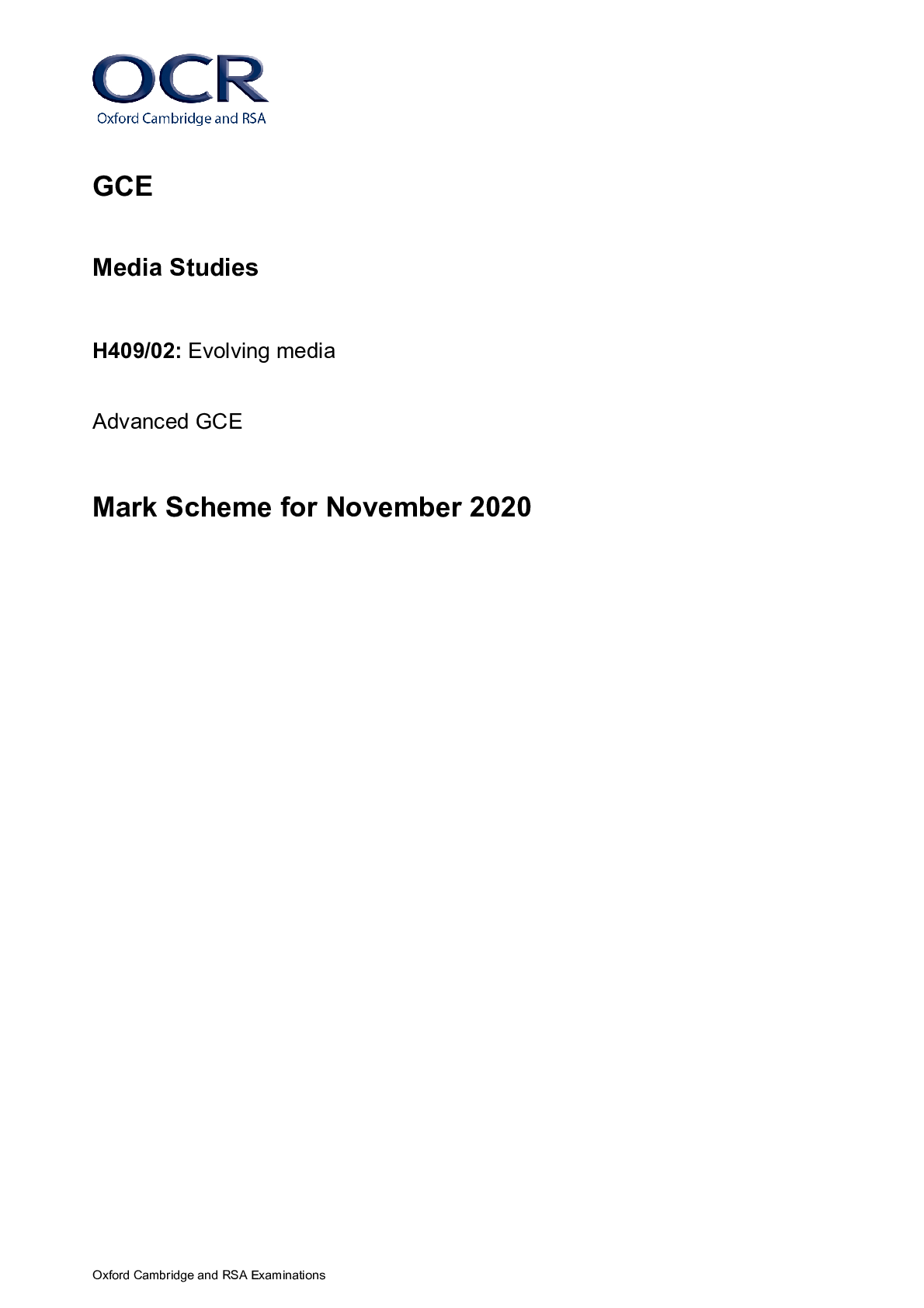
Buy this document to get the full access instantly
Instant Download Access after purchase
Add to cartInstant download
Reviews( 0 )
Document information
Connected school, study & course
About the document
Uploaded On
Oct 07, 2022
Number of pages
26
Written in
Additional information
This document has been written for:
Uploaded
Oct 07, 2022
Downloads
0
Views
101


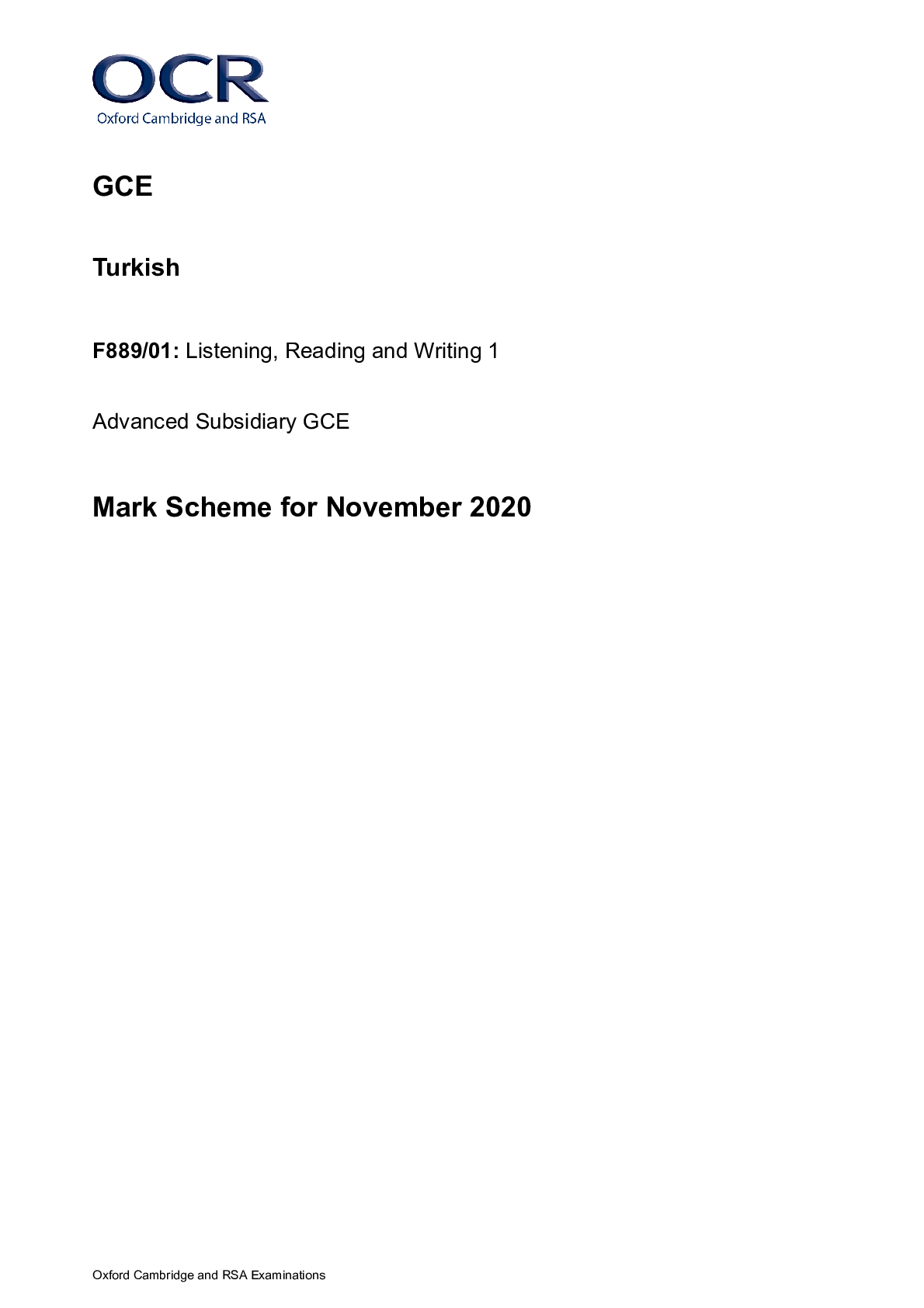
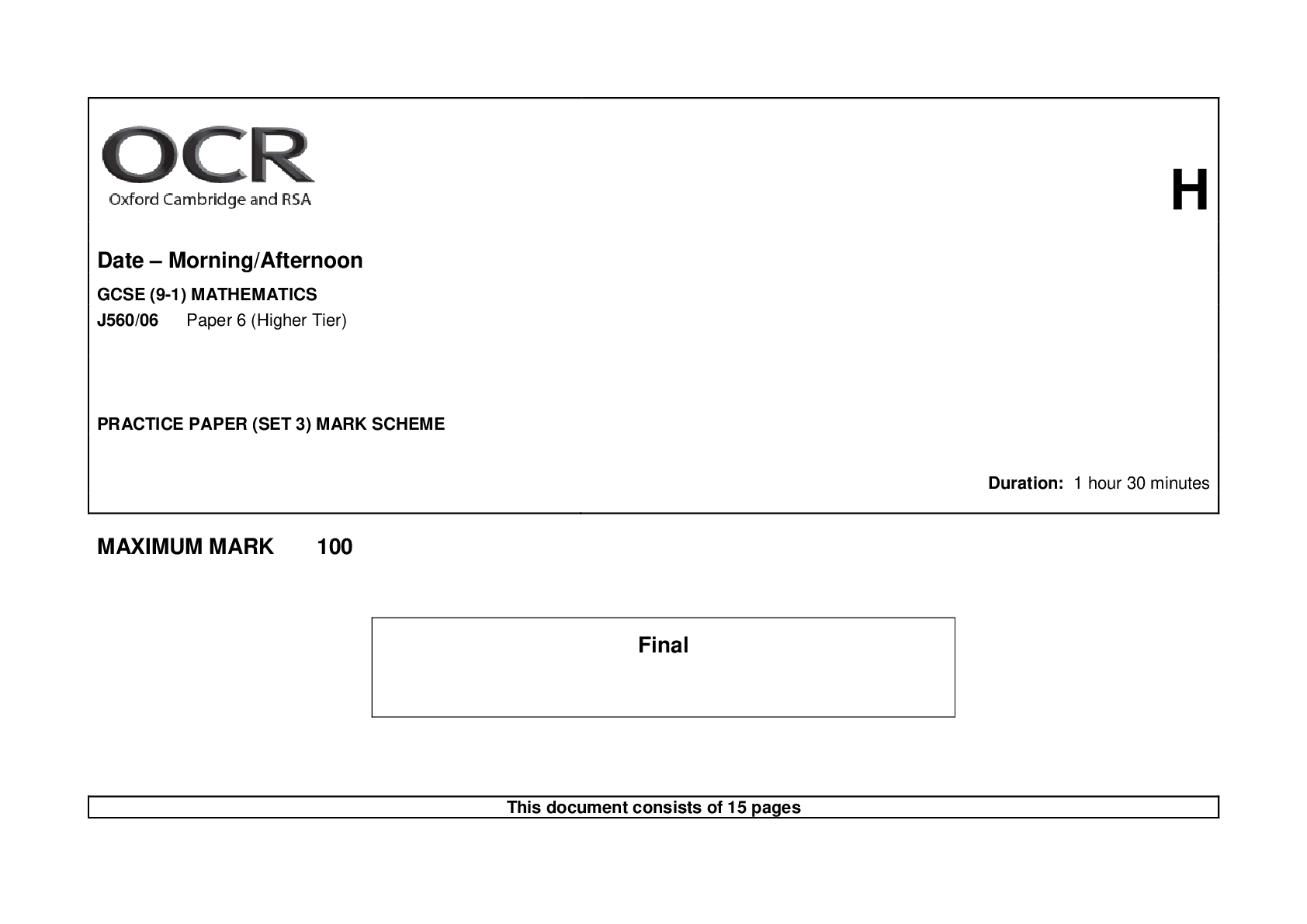


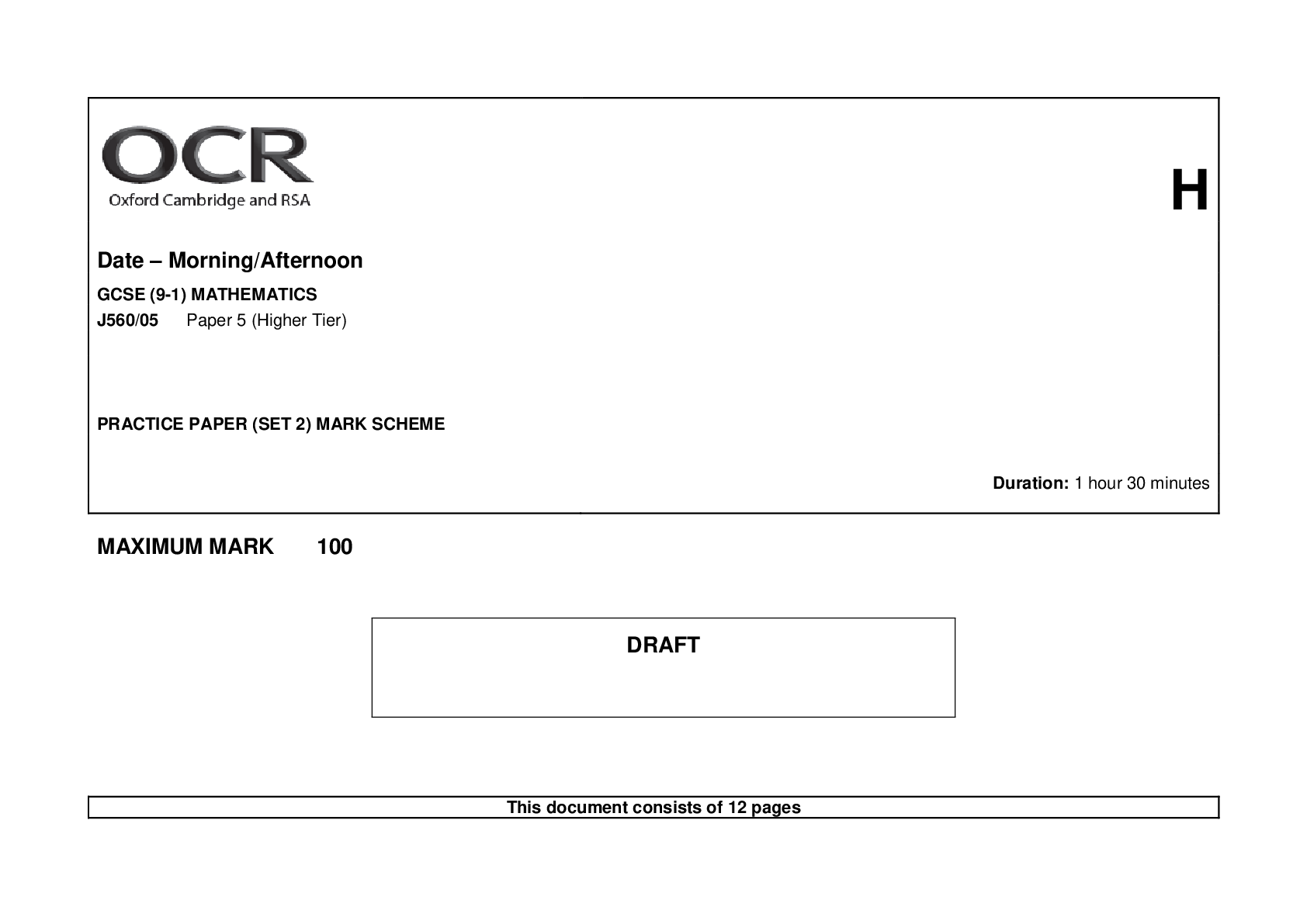
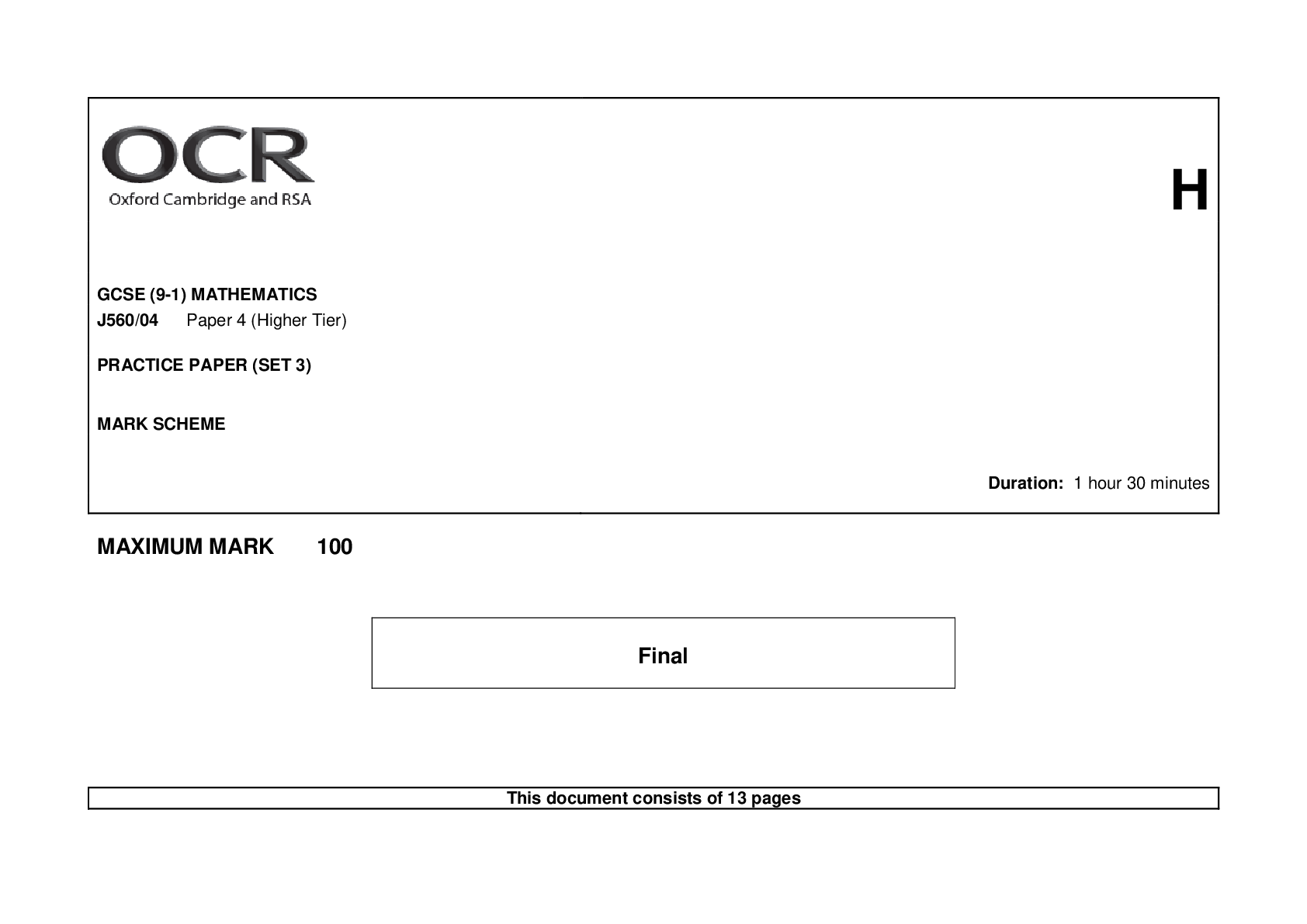
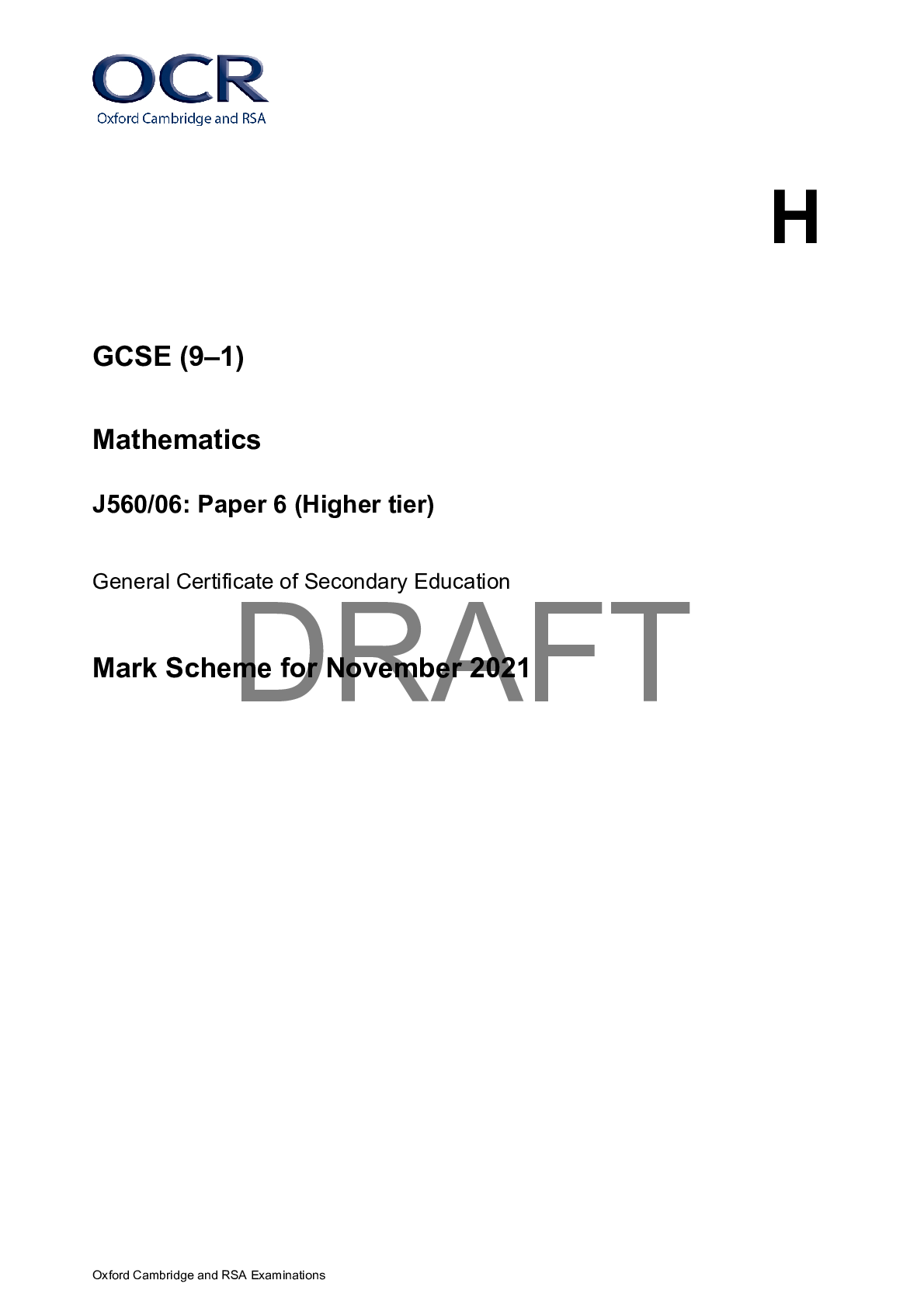

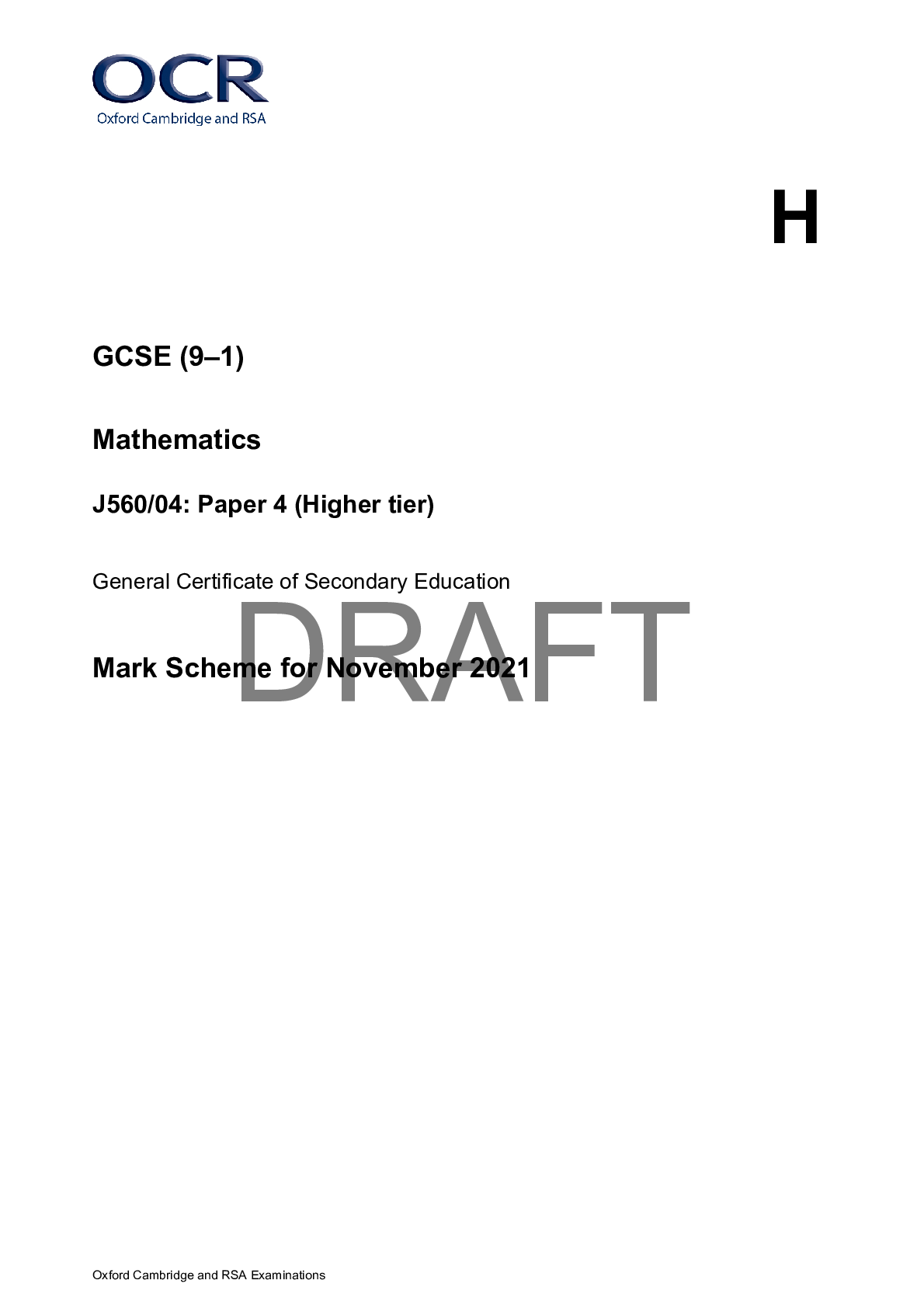
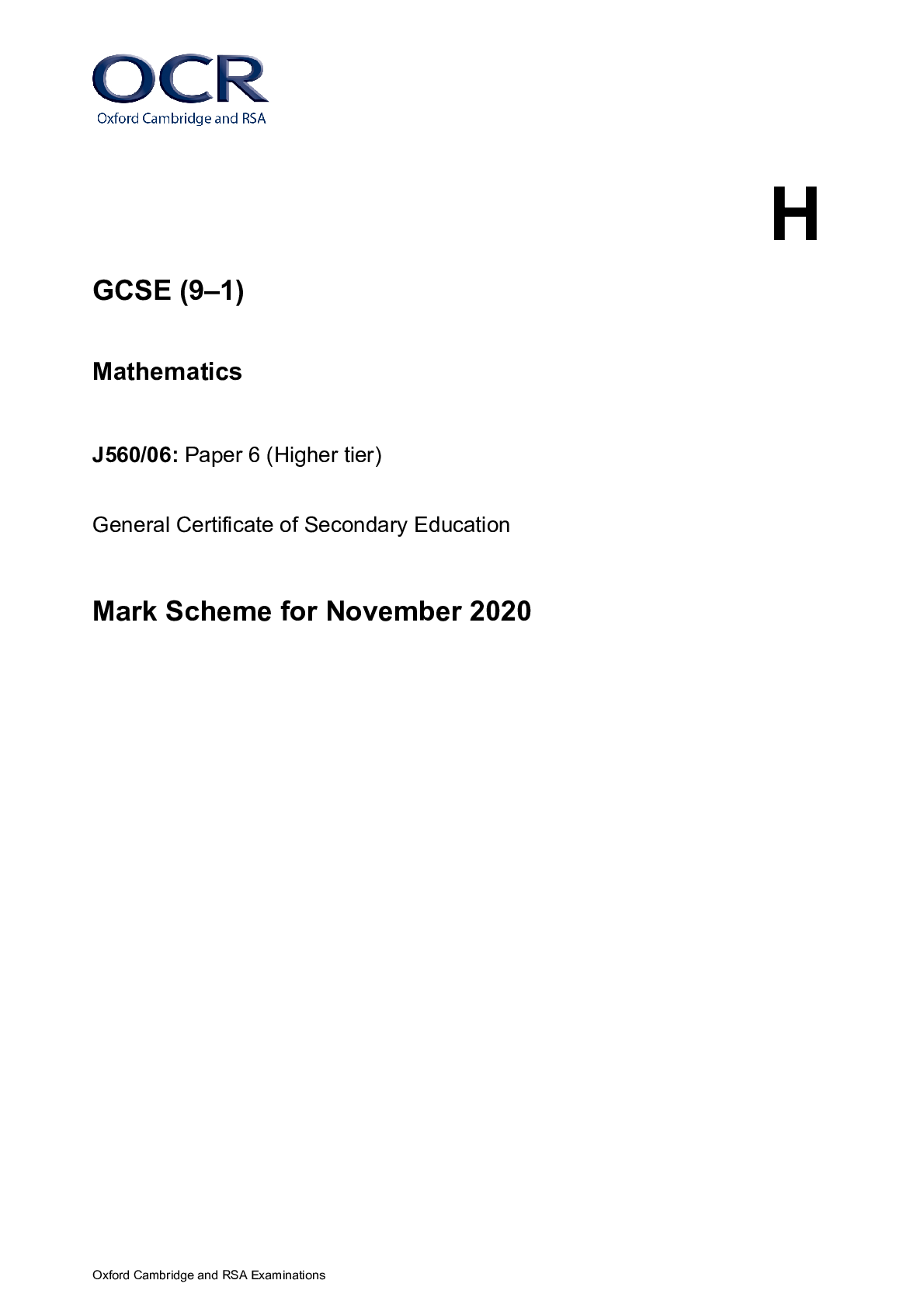
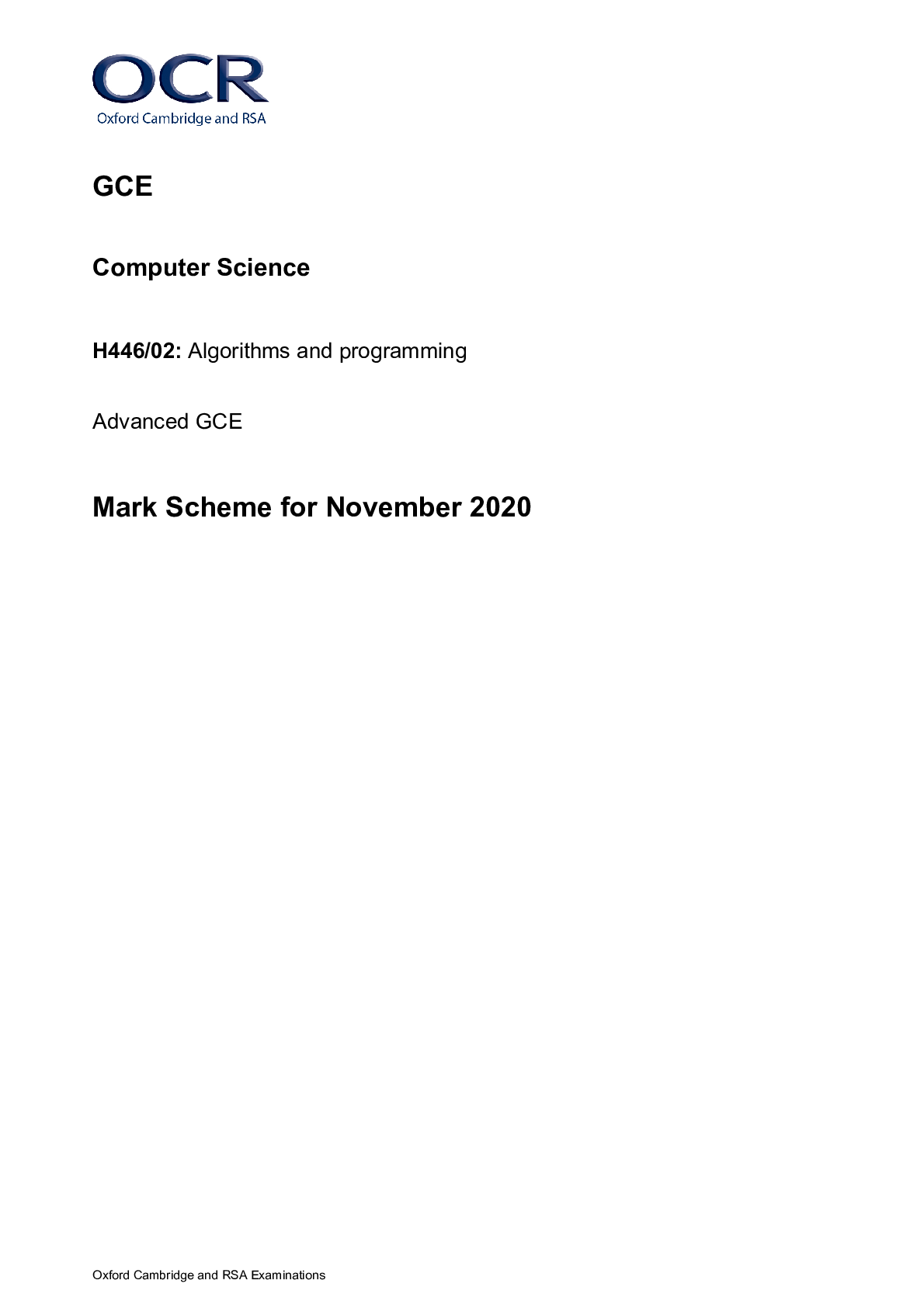
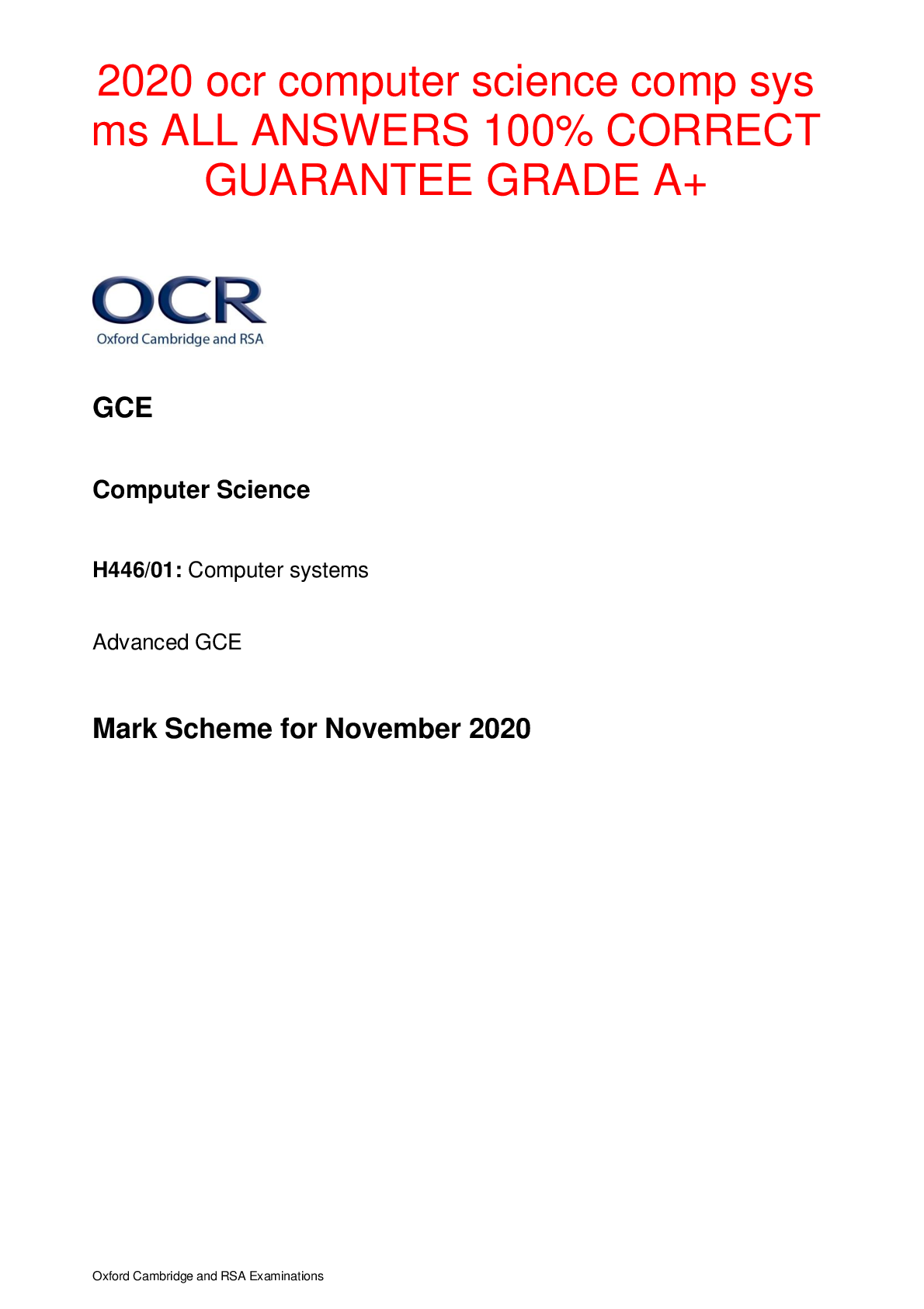
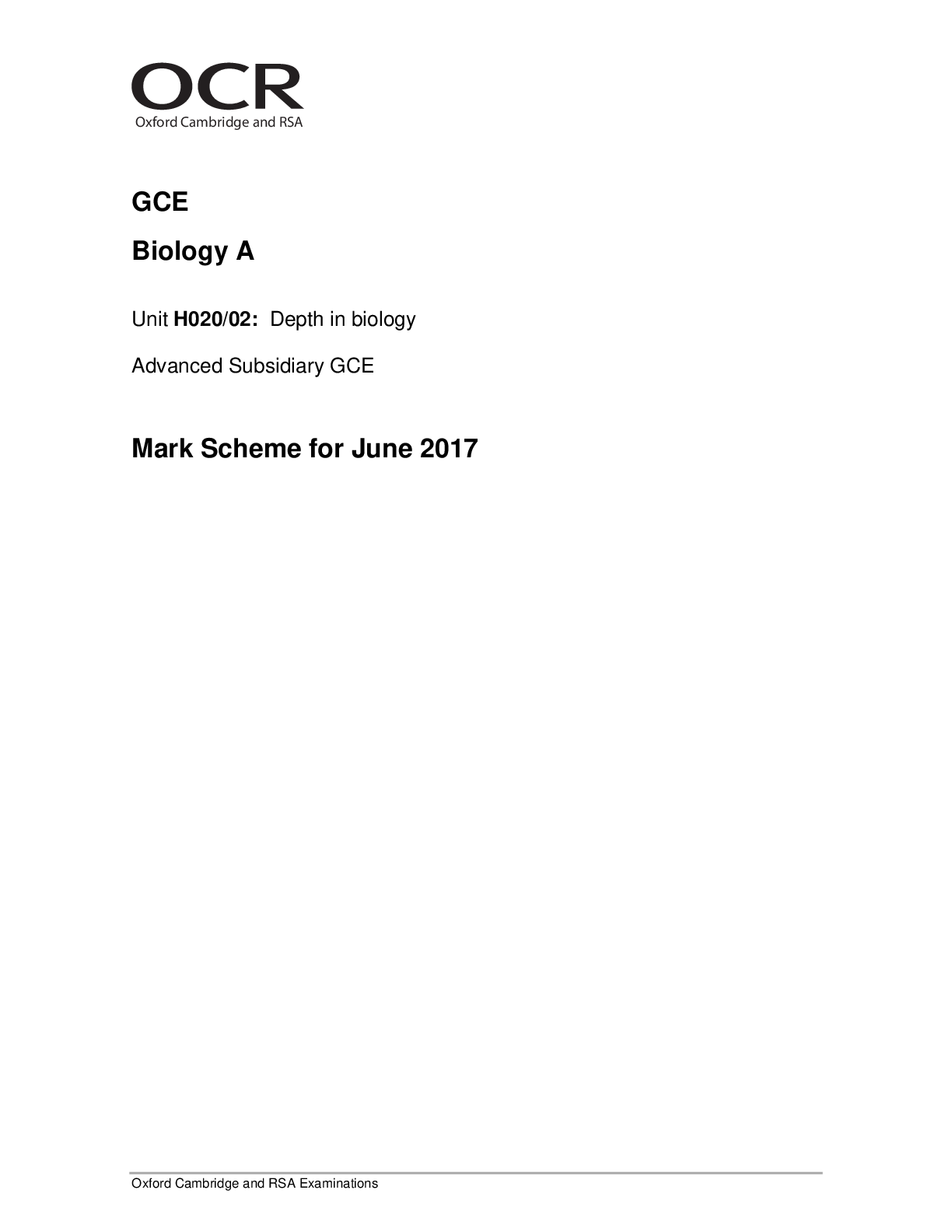


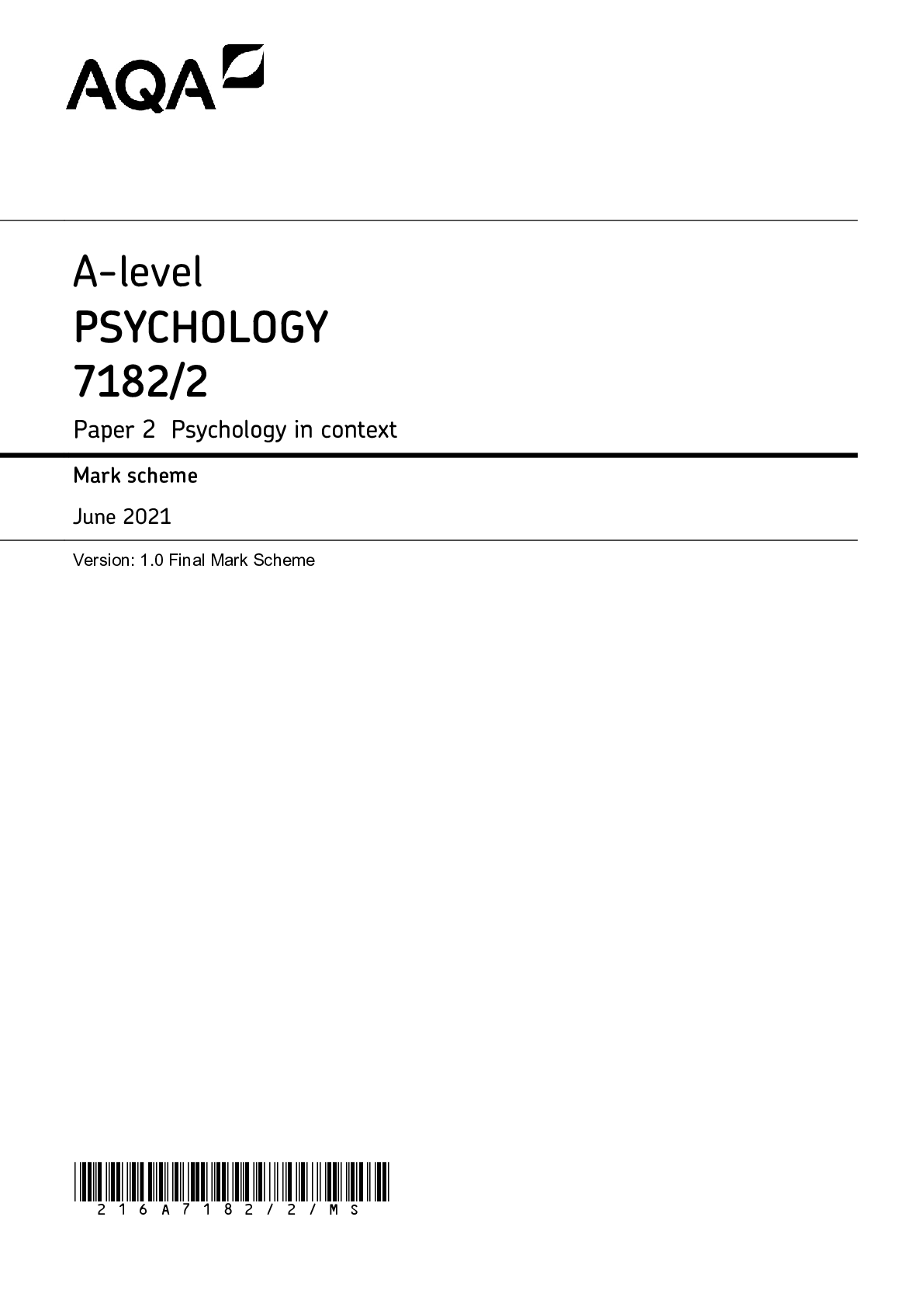
.png)
